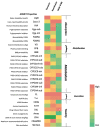Anti-COVID-19, Anti-Inflammatory, and Anti-Osteoarthritis Activities of Sesamin from Sesamum indicum L
- PMID: 38002386
- PMCID: PMC10669907
- DOI: 10.3390/bioengineering10111263
Anti-COVID-19, Anti-Inflammatory, and Anti-Osteoarthritis Activities of Sesamin from Sesamum indicum L
Abstract
During the COVID-19 (coronavirus disease 2019) outbreak, many people were infected, and the symptoms may persist for several weeks or months for recovering patients. This is also known as "long COVID" and includes symptoms such as fatigue, joint pain, muscle pain, et cetera. The COVID-19 virus may trigger hyper-inflammation associated with cytokine levels in the body. COVID-19 can trigger inflammation in the joints, which can lead to osteoarthritis (OA), while long-term COVID-19 symptoms may lead to joint damage and other inflammation problems. According to several studies, sesame has potent anti-inflammatory properties due to its major constituent, sesamin. This study examined sesamin's anti-inflammatory, anti-osteoarthritis, and anti-COVID-19 effects. Moreover, in vivo and in vitro assays were used to determine sesamin's anti-inflammatory activity against the RAW264.7 and SW1353 cell lines. Sesamin had a dose-dependent effect (20 mg/kg) in a monoiodoacetic acid (MIA)-induced osteoarthritis rat model. Sesamin reduced paw swelling and joint discomfort. In addition, the findings indicated that sesamin suppressed the expression of iNOS (inducible nitric oxide synthase) and COX-2 (cyclooxygenase-2) in the RAW264.7 cell line within the concentration range of 6.25-50 μM. Furthermore, sesamin also had a suppressive effect on MMP (matrix metalloproteinase) expression in chondrocytes and the SW1353 cell line within the same concentration range of 6.25-50 μM. To examine the anti-viral activity, an in silico analysis was performed to evaluate sesamin's binding affinity with SARS-CoV-2 RdRp (severe acute respiratory syndrome coronavirus 2 RNA-dependent RNA polymerase) and human ACE2 (angiotensin-converting enzyme 2). Compared to the controls, sesamin exhibited strong binding affinities towards SARS-CoV-2 RdRp and human ACE2. Furthermore, sesamin had a higher binding affinity for the ACE2 target protein. This study suggests that sesamin shows potential anti-SARS-CoV-2 activity for drug development.
Keywords: SARS-CoV-2 RdRp; anti-COVID-19; anti-inflammatory; anti-osteoarthritis; human ACE2; molecular docking.
Conflict of interest statement
The authors declare that they have no known competing financial interests or personal relationships that could appear to influence the work reported in this paper.
Figures













Similar articles
-
Sesamin lacks zebrafish embryotoxicity but exhibits evidence of anti-angiogenesis, anti-oxidant and anti-inflammatory activities.Comp Biochem Physiol C Toxicol Pharmacol. 2023 Jul;269:109637. doi: 10.1016/j.cbpc.2023.109637. Epub 2023 Apr 23. Comp Biochem Physiol C Toxicol Pharmacol. 2023. PMID: 37098389
-
In vitro and in vivo anti-osteoarthritis effects of tradition Chinese prescription Ji-Ming-San.J Ethnopharmacol. 2023 Apr 6;305:116084. doi: 10.1016/j.jep.2022.116084. Epub 2022 Dec 27. J Ethnopharmacol. 2023. PMID: 36584922
-
Myricetin possesses the potency against SARS-CoV-2 infection through blocking viral-entry facilitators and suppressing inflammation in rats and mice.Phytomedicine. 2023 Jul 25;116:154858. doi: 10.1016/j.phymed.2023.154858. Epub 2023 May 5. Phytomedicine. 2023. PMID: 37224774 Free PMC article.
-
A comprehensive review on the anti-cancer properties and mechanisms of action of sesamin, a lignan in sesame seeds (Sesamum indicum).Eur J Pharmacol. 2017 Nov 15;815:512-521. doi: 10.1016/j.ejphar.2017.10.020. Epub 2017 Oct 12. Eur J Pharmacol. 2017. PMID: 29032105 Review.
-
Therapeutic potential of green tea catechin, (-)-epigallocatechin-3-O-gallate (EGCG) in SARS-CoV-2 infection: Major interactions with host/virus proteases.Phytomed Plus. 2023 Feb;3(1):100402. doi: 10.1016/j.phyplu.2022.100402. Epub 2022 Dec 30. Phytomed Plus. 2023. PMID: 36597465 Free PMC article. Review.
References
-
- World Health Organization Coronavirus Dashboard. [(accessed on 15 March 2021)]. Available online: https://covid19.who.int/
-
- Docherty A.B., Harrison E.M., Green C.A., Hardwick H.E., Pius R., Norman L., Holden K.A., Read J.M., Dondelinger F., Carson G. Features of 20 133 UK Patients in Hospital with Covid-19 Using the ISARIC WHO Clinical Characterisation Protocol: Prospective Observational Cohort Study. bmj. 2020;2020:369. doi: 10.1136/bmj.m1985. - DOI - PMC - PubMed
-
- Wong A.Y.S., MacKenna B., Morton C.E., Schultze A., Walker A.J., Bhaskaran K., Brown J.P., Rentsch C.T., Williamson E., Drysdale H. Use of Non-Steroidal Anti-Inflammatory Drugs and Risk of Death from COVID-19: An OpenSAFELY Cohort Analysis Based on Two Cohorts. Ann. Rheum. Dis. 2021;80:943–951. doi: 10.1136/annrheumdis-2020-219517. - DOI - PMC - PubMed
Grants and funding
LinkOut - more resources
Full Text Sources
Research Materials
Miscellaneous

